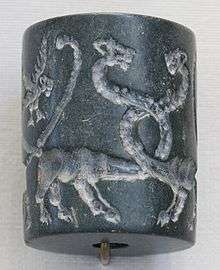Parthian language
| Parthian | |
|---|---|
| Arsacid Pahlavi | |
| Pahlawānīg | |
| Native to | Parthian Empire (incl. Arsacid dynasty of Armenia, Arsacid dynasty of Iberia and Arsacid Dynasty of Caucasian Albania) |
| Region | Parthia, ancient Iran |
| Era | State language 248 BC – 224 AD. Marginalized by Middle Persian from the 3rd century, though longer existent in the Caucasus due to several eponymous branches |
| Inscriptional Parthian, Manichaean alphabet | |
| Language codes | |
| ISO 639-3 |
xpr |
Linguist list |
xpr |
| Glottolog |
part1239[1] |
The Parthian language, also known as Arsacid Pahlavi and Pahlawānīg, is a now-extinct ancient Northwestern Iranian language spoken in Parthia, a region of northeastern ancient Iran. Parthian was the language of state of the Arsacid Parthian Empire (248 BC – 224 AD), as well as of its eponymous branches of the Arsacid dynasty of Armenia, Arsacid dynasty of Iberia, and the Arsacid dynasty of Caucasian Albania.
This language had a huge impact on Armenian, a large part of whose vocabulary was formed primarily from borrowings from Parthian.
Classification
Parthian was a Western Middle Iranian language. Language contact made it share some features of the Eastern Iranian language group, the influence of which is attested primarily in loanwords. Some traces of Eastern influence survive in Parthian loanwords in Armenian.[2]
Taxonomically, Parthian belongs to the Northwestern Iranian language group while Middle Persian belongs to the Southwestern Iranian language group.
Written Parthian
The Parthian language was rendered using the Pahlavi writing system, which had two essential characteristics: First, its script derived from Aramaic,[3] the script (and language) of the Achaemenid chancellery (i.e. Imperial Aramaic). Second, it had a high incidence of Aramaic words, rendered as ideograms or logograms, that is, they were written Aramaic words but understood as Parthian ones (See Arsacid Pahlavi for details).
The Parthian language was the language of the old Satrapy of Parthia and was used in the Arsacids courts. The main sources for Parthian are the few remaining inscriptions from Nisa and Hecatompolis, Manichaean texts, Sasanian multi-lingual inscriptions, and remains of Parthian literature in the succeeding Middle Persian. Among these, the Manichaean texts, composed shortly after the demise of the Parthian power, play an important role for reconstructing the Parthian language.[4] These Manichaean manuscripts contain no ideograms.
Attestations
Attestations of the Parthian language include:[5]
- Some 3,000 ostraca (ca. 100-29 BCE) found in Nisā in southern Turkmenistan).
- A first century AD parchment dealing with a land-sale from Awraman in south-west Iran.
- The first century BC ostraca from Kumesh in Eastern Iran.
- Inscription of on the coins of Arsacid Kings in the first century AD.
- The bilingual inscription of Seleucia, on the Tigris (150-151 AD).
- The inscription of Ardavan V found in Susa (215).
- Some third century documents discovered in Dura-Europos, On the Euphrates.
- The inscription at Kal-e Jangal, near Birjand in South Khorasan (first half of third century).
- The inscriptions of early Sassanian Kings and priests in Parthian including Ka'ba-ye Zartosht near Shiraz and Paikuli in Iraqi Kurdistan.
- The vast corpus of Manichaean Parthian which do not contain any ideograms.
- In North Pakistan, Indo-Parthian culture in Taxila with Gondophares 20 BC–10 BC and Abdagases, Bajaur, Bajaur, Khyber-Pakhtunkhwa and down in to Sistan, Balochistan.
Extinction
In 224 AD, Ardashir I, the local ruler of Pars, deposed and replaced Artabanus IV, the last Parthian Emperor, and founded the fourth Iranian dynasty, and the second Persian dynasty, the Sassanian Empire. Parthian was then succeeded by Middle Persian, which when written is known as Sasanian Pahlavi. Parthian did not die out immediately, but remains attested in a few bi-lingual inscriptions from the Sasanian era.
See also
- Avestan language
- Old Persian language
- Middle Persian
- Persian language and history of Persian language
- Pahlavi literature
- Iranian languages vocabulary comparison table
References
Notes
- ↑ Hammarström, Harald; Forkel, Robert; Haspelmath, Martin; Bank, Sebastian, eds. (2016). "Parthian". Glottolog 2.7. Jena: Max Planck Institute for the Science of Human History.
- ↑ Lecoq, Pierre (1983). "Aparna". Encyclopedia Iranica. 1. Costa Mesa: Mazda Pub. http://www.iranicaonline.org/articles/aparna-c3k
- ↑ Iran Chamber Society
- ↑ Josef Wiesehfer, "Ancient Persia: From 550 Bc to 650 A.D.", translated by Azizeh Azado, I.B. Tauris, 2001. p. 118.
- ↑ Tafazzoli, A.; Khromov, A.L. "Sasanian Iran: Intellectual Life" in History of civilizations of Central Asia, UNESCO, 1996. Volume 3
General references
- Lecoq, Pierre (1983). "Aparna". Encyclopedia Iranica. 1. Costa Mesa: Mazda Pub.
- Hugh Chisholm, ed. (1911). "Parthia". Encyclopaedia Britannica. 20. London: Cambridge University Press. p. 871.
- Boyce, Mary; Ghirshman, R. (1979). "Review: R. Ghirshman's L'Iran et la Migration des Indo-Aryens et des Iraniens". Of the American Oriental Society. Journal of the American Oriental Society, Vol. 99, No. 1. 99 (1): 119–120. doi:10.2307/598967. JSTOR 598967.
External links
- Some valuable texts in Parthian including Boyce, Mary The Manichaean hymn-cycles in Parthian (London Oriental Series, Vol. 3). London: Oxford University Press, 1954.
- [ARMENIA AND IRAN iv. Iranian influences in Armenian Language Covers the massive lexical and vocabulary influences of Parthian on Armenian, (R. Schmitt, H. W. Bailey), originally published 1986.]
